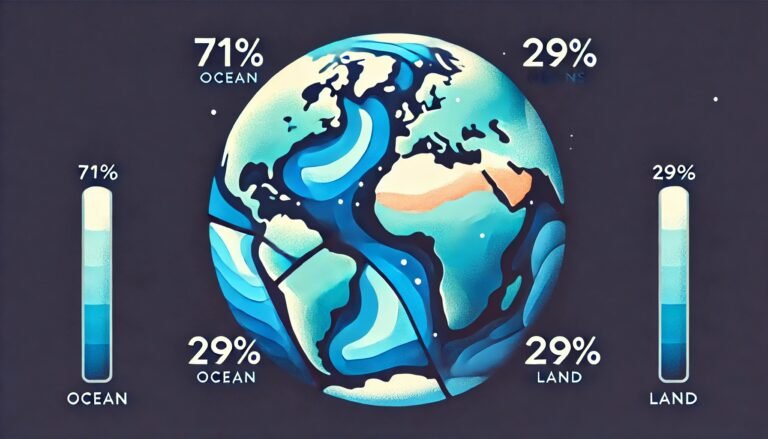Answer
Approximately 71% of Earth’s surface is covered by water, primarily in oceans, seas, and other bodies of water.
Simple Explanation
Think of Earth as a giant blue marble! About 7 out of every 10 parts of this marble are covered with water, making our planet look blue from space.
Detailed Explanation
Earth is often called the “Blue Planet” because of its unique water coverage. Of the 71% of the surface that is water, about 96.5% is found in the oceans. The oceans are crucial for regulating the planet’s climate and supporting a vast range of marine life. The rest of the water is found in rivers, lakes, ice caps, and glaciers.
Distribution of Water on Earth
- Oceans: Covering about 61% of Earth’s total surface, oceans are the largest reservoirs of water on the planet.
- Freshwater Sources: Only about 2.5% of Earth’s water is freshwater, which is vital for drinking, agriculture, and sanitation. Most of this freshwater is trapped in glaciers and ice caps, while only a small fraction is accessible in rivers and lakes.
The presence of water is not just essential for life; it also plays a significant role in weather patterns and the Earth’s geology. For instance, the movement of water through oceans and the atmosphere influences global climate systems.
Conclusion
Water covers a significant portion of Earth’s surface, approximately 71%, which is vital for life and ecological balance. Understanding this can help us appreciate the importance of preserving our water resources.
FAQ
Q: What portion of Earth’s water is saltwater?
A: About 97.5% of Earth’s water is saltwater, primarily found in the oceans.
Q: How much of Earth’s water is available for human use?
A: Roughly 0.3% of all Earth’s water is easily accessible for human use as fresh water in lakes, rivers, and reservoirs.
Q: Why is water distribution important?
A: Uneven distribution of water affects agriculture, drinking water availability, and ecosystems, making conservation and management essential.
Q: Can Earth’s water supply run out?
A: While the total volume of water remains constant, pollution and overuse can threaten the availability of clean, usable water.
External Sources
Find more information about Earth’s water coverage from National Geographic and USGS.




